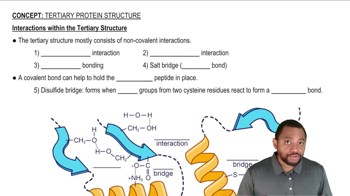Name the bases in the pentanucleotide with the sequence G-A-U-C-A. Does this come from RNA or DNA? Explain.
Ch.26 Nucleic Acids and Protein Synthesis
Chapter 26, Problem 26.69
There are different tRNAs for each amino acid. What is one major way to differentiate among the tRNAs for each amino acid?
 Verified step by step guidance
Verified step by step guidance1
tRNAs are differentiated by their anticodon sequences, which are complementary to the mRNA codons.
Each tRNA molecule has a specific anticodon that pairs with a corresponding codon on the mRNA during protein synthesis.
The anticodon-codon pairing ensures that the correct amino acid is added to the growing polypeptide chain.
Additionally, tRNAs have specific structural features and modifications that help in their recognition by the correct aminoacyl-tRNA synthetase enzyme.
These enzymes are responsible for attaching the correct amino acid to its corresponding tRNA, further ensuring the fidelity of protein synthesis.

Verified Solution
Video duration:
1mWas this helpful?
Key Concepts
Here are the essential concepts you must grasp in order to answer the question correctly.
tRNA Structure
Transfer RNA (tRNA) is a small RNA molecule that plays a crucial role in protein synthesis by transporting amino acids to the ribosome. Each tRNA has a specific three-dimensional structure that includes an anticodon region, which pairs with the corresponding codon on mRNA, and an acceptor stem where the amino acid is attached. The unique structure of each tRNA allows it to recognize and bind to its specific amino acid.
Recommended video:
Guided course

Structural Formula Concept 2
Amino Acid Specificity
Each tRNA is linked to a specific amino acid through a process called aminoacylation, which is catalyzed by enzymes known as aminoacyl-tRNA synthetases. These enzymes ensure that the correct amino acid is attached to its corresponding tRNA, thus maintaining the fidelity of protein synthesis. The specificity of this attachment is a key factor in differentiating among the various tRNAs.
Recommended video:
Guided course

Specific Gravity
Anticodon-Codon Interaction
The anticodon is a sequence of three nucleotides on the tRNA that is complementary to a specific codon on the mRNA. This interaction is essential for the accurate translation of genetic information into proteins. The unique sequence of the anticodon allows for the differentiation of tRNAs, as each tRNA recognizes a specific codon corresponding to its associated amino acid.
Recommended video:
Guided course

Interactions within the Tertiary Structure Concept 2
Related Practice
Textbook Question
22
views
Textbook Question
What tetrapeptide is synthesized from the informational DNA sequence G-T-C-A-G-T-A-C-G-T-T-A?
27
views
Textbook Question
What is the general shape and structure of a tRNA molecule?
30
views
Textbook Question
Insulin is synthesized as preproinsulin, which has 81 amino acids. How many heterocyclic bases must be present in the informational DNA strand to code for preproinsulin (assuming no introns are present)?
21
views
Textbook Question
Suppose that 22% of the nucleotides of a DNA molecule are deoxyadenosine and during replication the relative amounts of available deoxynucleoside triphosphates are 22% dATP, 22% dCTP, 28% dGTP, and 28% dTTP. What deoxynucleoside triphosphate is limiting to the replication? Explain.
21
views
Textbook Question
Write the complementary sequence of bases for each DNA strand shown next.
a. 5′T-A-T-A-C-T-G 3′
18
views
